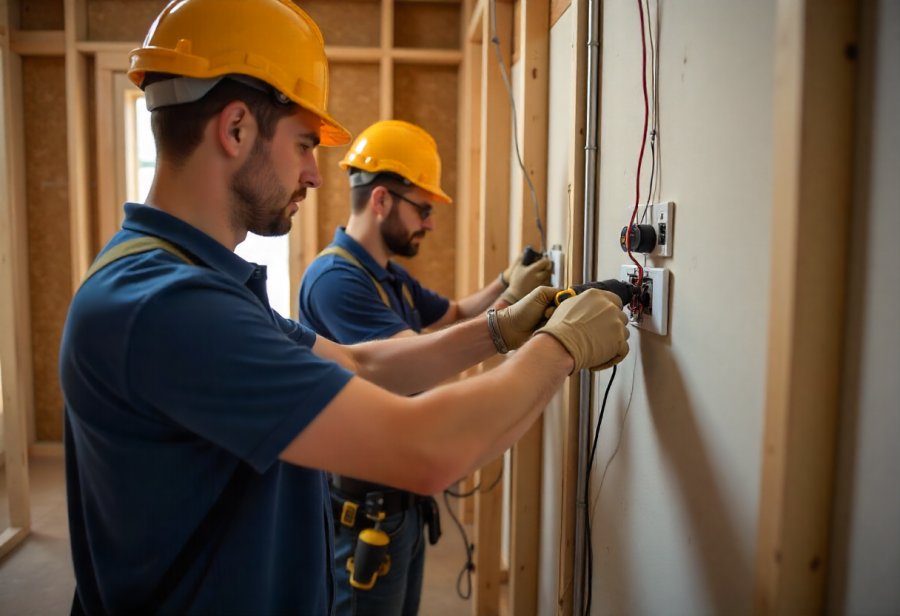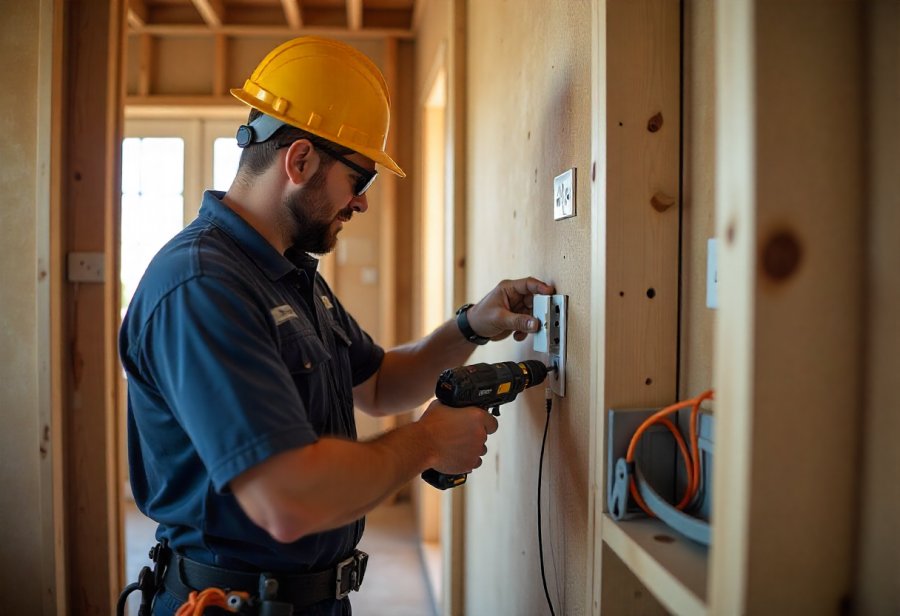Behind every safe, functioning home lies the craftsmanship of skilled electricians who transform chaos into reliable power systems through meticulous planning, wiring, and safety compliance. But what makes their work so vital? This compelling exploration reveals how electricians navigate complex challenges—using specialized tools and adhering to strict safety standards—to ensure homes are powered efficiently and securely. From understanding fundamental electrical principles to troubleshooting intricate wiring issues, their expertise safeguards against hazards like shocks and fires. As technology evolves, so does their skill set, embracing smart systems and new safety measures that shape the future of residential wiring. This journey into the hidden techniques and ongoing innovations raises a crucial question: How do electricians master precision and safety amid increasing complexity, ensuring every home they wire is a beacon of dependability?

Mastering Safety, Precision, and Expertise in Home Electrical Work
Electrical work in homes might look simple at first glance, but behind the scenes, it’s all about safety, precision, and expertise. A small mistake—whether it’s wiring a circuit incorrectly or choosing the wrong breaker—can lead to serious hazards like electrical fires, shocks, or system failures. That’s why professional electricians focus on accuracy at every stage, from reading blueprints to making connections. Their thorough understanding of electrical principles and strict adherence to safety standards are what prevent accidents and ensure the system’s reliability.
Electricians are the architects of order in a tangled world of wires. They take complex, chaotic setups and turn them into safe, dependable power sources that keep homes running smoothly. Their work extends beyond simply installing outlets and switches; it involves designing and executing systems that meet all safety codes and modern demands. Every wire they run and connection they make is carefully planned and executed to minimize risks and maximize performance.
Tools and techniques are fundamental to this process. Electricians rely on specialized equipment—wire strippers for clean cuts, voltage testers to verify circuits are de-energized, and fish tapes to navigate tight spaces. Using the right tools isn’t just about convenience; it’s about protecting themselves and the home’s inhabitants from hazards. Proper tool use ensures wiring is neat, durable, and safe from faults that could cause fires or shocks.
Following electrical safety standards and building codes isn’t optional—it’s essential. Regulations like the National Electrical Code (NEC) set the baseline for safe wiring practices, grounding, and circuit protection. Electricians must be familiar with local codes and pass inspections that serve as a final safeguard. Compliance isn’t just about legality; it’s about protecting lives and property by reducing the risk of electrical failures.
The process of wiring a home involves careful planning, execution, and testing. Electricians start with a clear blueprint, mapping out outlet, switch, and fixture locations while considering safety and future needs. During installation, they double-check connections, test circuits, and troubleshoot issues to ensure everything functions correctly. This meticulous approach transforms raw materials into a reliable, safe system that powers homes day after day, providing peace of mind for homeowners.
Building a Solid Foundation: Key Concepts and Terminology in Electrical Systems
Understanding the basics of electrical systems is essential for anyone involved in or around home wiring. Central to this knowledge are key concepts like voltage, current, resistance, and power. Voltage acts as the force pushing electrical energy through wires, while current is the actual flow of that energy. Resistance opposes this flow, and power measures how much work the system is performing. Grasping how these elements interact helps electricians design, troubleshoot, and maintain circuits effectively.
Electricians use a specialized vocabulary to communicate complex ideas clearly. Terms such as circuits, breakers, grounding, and wiring methods form the language of their daily work. Circuits connect the power source to outlets and fixtures, with breakers serving as safety switches that cut off power during overloads. Grounding provides a safe path for excess electricity, reducing shock risks. Understanding these terms ensures clear communication and adherence to safety protocols.
Fundamental principles like Ohm’s Law are the backbone of electrical work. This law states that voltage equals current times resistance (V = I x R). It allows electricians to calculate the correct wire sizes and circuit loads, preventing overloads that could cause fires or damage. Applying these principles ensures systems are both safe and efficient, providing reliable power for everyday use.
Building a strong foundation in electrical concepts helps prevent common mistakes and enhances safety. For example, choosing the right wire gauge depends on understanding the expected current flow and resistance. Misjudging this can lead to overheating or short circuits. Similarly, reading wiring diagrams accurately reduces errors during installation and simplifies troubleshooting if issues arise later. These core skills are essential stepping stones for more advanced work.
Safety awareness is woven into every aspect of electrical work. Electricians must recognize hazards such as live wires, improper grounding, or overloaded circuits. They rely on protective gear like insulated gloves and tools designed for high voltages. Following safety standards isn’t just about compliance; it’s about protecting themselves and homeowners from shocks and fires. A solid understanding of fundamentals helps identify risky situations early and respond appropriately.
In residential wiring, precise planning and understanding technical basics are vital. Electricians create detailed layouts before starting work, considering how each wire and component interacts within the system. This careful planning ensures circuits are correctly rated and connections are solid, reducing costly errors or unsafe configurations. Mastery of these foundational concepts guarantees a safe, reliable electrical system capable of supporting modern home demands.
Continual education and staying current with industry standards reinforce these basics. Electrical codes like the NEC are regularly revised to incorporate new safety insights and technological advances. Electricians utilize digital tools such as circuit analyzers and thermal imaging cameras to detect issues early, allowing for preventive measures. This proactive approach helps maintain safety and extend the lifespan of residential electrical systems.
Having a firm grasp of electrical fundamentals, combined with ongoing learning, is key to successful and safe wiring. It’s about more than passing inspections; it’s about building confidence in systems that power daily life. As homes incorporate more smart devices and energy-efficient features, these core principles serve as the foundation for adapting safely to new challenges. Staying rooted in these basics ensures electricians can meet evolving demands and uphold high safety standards.
Transform Your Home with Expert Electrical Services in Greater Toronto Area
Looking for reliable electrical solutions in the Greater Toronto Area? North York Electricians (NYE) specializes in residential wiring, lighting design, and comprehensive electrical repairs. Our team excels in installing and configuring smart switches, thermostats, security systems, and home automation to enhance your living space. We also prioritize energy efficiency by upgrading to eco-friendly LED lighting, energy-saving panels, and sustainable electrical designs. Whether you need upgrades or troubleshooting, our skilled electricians ensure safe and modern electrical systems. For professional electrical installation, contact us today at (416) 508-0206 or visit North York Electricians to discover how we can transform your home with cutting-edge electrical solutions.

Designing and Troubleshooting Electrical Systems for Reliability and Safety
Electricians approach system design and troubleshooting with a focus on safety, precision, and efficiency. When planning wiring layouts, they begin by analyzing blueprints and assessing the space to determine the most logical routes for wiring, outlets, and switches. Good planning considers both current needs and potential future upgrades, helping to avoid costly adjustments later. This careful preparation ensures the system complies with safety standards and operates reliably over time.
Troubleshooting starts with a systematic process. Electricians gather information from homeowners about the issues they’re experiencing, then shut off power before inspecting circuits. Using diagnostic tools like voltage testers and multimeters, they methodically test connections and components to locate faults. This approach allows them to isolate problems quickly and accurately, minimizing damage and reducing safety risks. Their experience guides them in interpreting test results and making targeted repairs.
Dealing with complex wiring challenges often requires adaptability and problem-solving skills. Limited space, outdated wiring, or hidden faults inside walls can complicate repairs. Electricians rely on specialized tools such as fish tapes and flexible conduits to navigate tight or tricky areas. When necessary, they upgrade or reconfigure circuits to meet modern safety standards, especially in older homes. These adjustments demand a blend of technical expertise and creative thinking to maintain system integrity.
Throughout the process, electricians organize wiring routes carefully, double-check connections, and verify system operation with testing equipment. Their ability to adapt to unforeseen obstacles—like structural constraints or hidden wiring—ensures the system remains safe and functional. Every troubleshooting step aims to transform tangled, unreliable wiring into a cohesive electrical network that homeowners can trust.
Designing and troubleshooting systems also involves anticipating future demands. Electricians calculate load capacities and safety margins to prevent overloads as homes grow or modernize. When problems arise, they don’t just fix the immediate fault—they analyze root causes to prevent recurrence. This proactive mindset promotes long-term safety and system durability, ensuring a reliable power supply that adapts to changing needs and technologies.
For homeowners and professionals seeking comprehensive guidance, exploring resources on electrical safety and best practices can be highly beneficial. Learning more about how to effectively troubleshoot and design reliable systems can help prevent future issues and ensure safety. To deepen your understanding, consider visiting Electrical Safety Resources for valuable information on maintaining and upgrading your electrical systems.
Turning Knowledge into Practice: Safe and Effective Wiring in Real Homes
Applying electrical knowledge in real-world scenarios means turning careful planning into precise action. Electricians begin by assessing the space thoroughly, understanding the specific needs of the home, and designing a wiring layout that balances safety, efficiency, and room for future upgrades. They select the right tools—wire strippers, voltage testers, fish tapes—and use them with care to ensure each step is safe and accurate. Proper techniques during installation help prevent faults and hazards that could compromise the system later on.
Attention to detail is essential during wiring. Electricians double-check every connection, making sure wires are securely fastened, properly insulated, and correctly routed. They verify grounding and circuit ratings to match the planned load, testing circuits with reliable tools to catch issues early. This disciplined approach not only guarantees functionality but also contributes to the system’s long-term durability, reducing the chance of future problems.
Safety remains a top priority throughout the process. Electricians systematically turn off the main power before working on any circuit, wearing protective gear and following established standards. Clear documentation—labeling circuits and wires—ensures future troubleshooting is straightforward and safe. This meticulous record-keeping helps protect homeowners and electricians alike from shocks, shorts, or fires, reinforcing the importance of careful, standardized procedures.
Dealing with unexpected challenges, like limited space inside walls or outdated wiring, requires quick thinking and adaptability. Electricians may reroute wires, upgrade components, or use flexible conduits to navigate tight or complex areas. Their experience helps them find solutions that uphold safety standards while meeting the home’s needs. This problem-solving ability ensures that even in difficult conditions, the system remains reliable and safe.
Every step from assessment to final testing emphasizes accuracy. Electricians verify grounding, check circuit integrity, and test all connections with precision tools. They ensure each component functions as intended, avoiding shortcuts that could introduce hazards later. This thorough approach builds confidence that the system will perform reliably under daily use.
Beyond installation, electricians consider future demands. They calculate load capacities carefully, leaving room for additional appliances or upgrades. When issues arise, they analyze root causes rather than just patching symptoms, preventing recurring problems. This proactive mindset extends the life of the system and ensures safety as the household evolves.
The practical application of electrical knowledge hinges on discipline, focus, and a methodical approach. Electricians rely on their training and experience to translate plans into safe, effective wiring. Every connection is a link in a chain of safety, durability, and performance, giving homeowners peace of mind that their electrical system is built to last.
Mastering these real-world skills isn’t just about following a checklist; it’s about embedding safety and quality into every action. By applying their knowledge with care and precision, electricians create systems that power homes reliably and safely, adapting seamlessly to the changing needs of modern living.

Evolving Skills and Technologies Shaping the Future of Electrical Safety
The landscape of electrical safety and skills is changing rapidly, driven by technological advancements and stricter standards. Today’s homes are becoming smarter, integrating interconnected systems that control lighting, security, and climate via the internet. Electricians must stay ahead of these trends through continuous education and certification, ensuring they can handle the growing complexity of modern wiring. Keeping pace with new tools, materials, and techniques isn’t just beneficial—it’s essential for maintaining high safety standards in every project.
As safety regulations evolve, so do the tools and methods used to uphold them. The National Electrical Code (NEC) and similar standards are revised regularly to reflect the latest safety insights and technological innovations. Electricians now rely on digital devices like thermal imaging cameras and circuit analyzers that help identify potential hazards early. This shift from reactive repairs to proactive safety measures means problems are often addressed before they become dangerous, improving overall system reliability and homeowner protection.
The rise of smart home technology and energy-efficient systems has expanded the skill set required of electricians. Installing and troubleshooting connected devices such as smart thermostats or automated lighting demands familiarity with digital networks and cybersecurity principles. This broader knowledge base allows electricians to deliver comprehensive, future-proof solutions that meet modern safety and efficiency needs. Embracing these innovations helps them stay relevant and adds value for homeowners looking for advanced, safe electrical systems.
Looking ahead, the complexity of residential wiring will only grow as homes become more interconnected. Electricians will need to deepen their understanding of digital systems, renewable energy integrations, and data security. Ongoing training and active participation in industry associations will be crucial for staying current. Those committed to lifelong learning will be better equipped to adapt to emerging challenges, ensuring safety remains the top priority even as technology evolves.
This ongoing pursuit of knowledge isn’t solely about technical mastery; it’s about cultivating an adaptable mindset. Electricians who embrace change, engage with new standards, and refine their skills will lead the way in delivering safer, more reliable home electrical systems. Their willingness to learn and innovate directly benefits homeowners, providing systems that are not only up-to-date but also resilient against future risks.
The future of electrical safety depends on continuous improvement and proactive adaptation. Electricians who prioritize ongoing education, stay engaged with industry developments, and incorporate new tools and practices will uphold the highest safety standards. As the residential landscape becomes more sophisticated, their expertise will be vital in ensuring homes remain powered safely, efficiently, and ready for the innovations to come.







